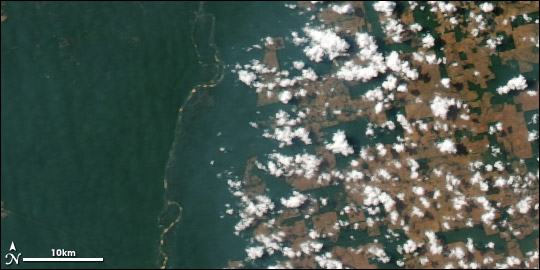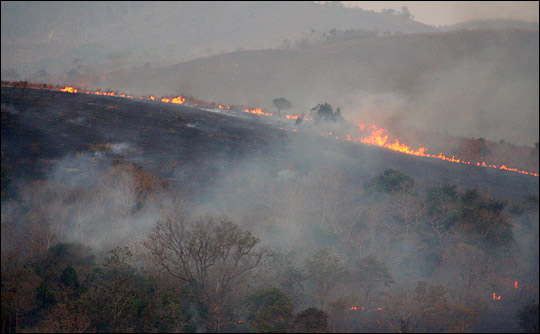

Climate Impacts: Rainfall and Temperature | |||
Up to thirty percent of the rain that falls in tropical forests is water that the rainforest has recycled into the atmosphere. Water evaporates from the soil and vegetation, condenses into clouds, and falls again as rain in a perpetual self-watering cycle. In addition to maintaining tropical rainfall, the evaporation cools the Earth’s surface. In many computer models of future climate, replacing tropical forests with a landscape of pasture and crops creates a drier, hotter climate in the tropics. Some models also predict that tropical deforestation will disrupt rainfall pattern far outside the tropics, including China, northern Mexico, and the south-central United States. Most of these climate predictions of decreased rainfall are based on a uniform and virtually complete replacement of tropical forests with pasture and cropland. However, deforestation often proceeds in a patchwork fashion—clearings that branch off roads in a fishbone pattern, for example, or deforested islands within a sea of forest. On these local scales, deforestation may actually increase rainfall by creating “heat islands” that enhance the rising and overturning of air (convection) that leads to clouds and rain. Clouds and rainfall becomes concentrated over clearings. Whether the localized enhancement of rainfall will persist as larger and larger areas of forest are cleared is not currently known. Answers may come from more sophisticated climate models that accurately represent the patchwork progression of partially deforested landscapes. |
|||
 | |||
The Carbon Cycle and Global WarmingIn the Amazon alone, scientists estimate that the trees contain more carbon than 10 years worth of human-produced greenhouse gases. When people clear the forests, usually with fire, carbon stored in the wood returns to the atmosphere, enhancing the greenhouse effect and global warming. Once the forest is cleared for crop or grazing land, the soils can become a large source of carbon emissions, depending on how farmers and ranchers manage the land. In places such as Indonesia, the soils of swampy lowland forests are rich in partially decayed organic matter, known as peat. During extended droughts, such as during El Niño events, the forests and the peat become flammable, especially if they have been degraded by logging or accidental fire. When they burn, they release huge volumes of carbon dioxide and other greenhouse gases. |
Deforestation changes local weather. Cloudiness and rainfall can be greater over cleared land (image right) than over intact forest (left). This image of Alta Floresta, Brazil, was captured by the Moderate Resolution Imaging Spectroradiometer (MODIS) aboard NASA’s Aqua satellite on August 29, 2006. (NASA image by Robert Simmon and Jesse Allen, based on data from the MODIS science team.) | ||
 | |||
It is not certain whether intact tropical forests are a net source or sink of carbon. Certainly, the trunks of trees are a large, stable pool of carbon that grows as forests mature or regenerate on previously cleared land. But trees, plants, and microorganisms in the soil also respire, releasing carbon dioxide as they break down carbohydrates for energy. In the Amazon, huge volumes of carbon dioxide escape from decaying leaves and other organic matter in rivers and streams that flood large areas of forest during the rainy season. Undisturbed tropical forests may be nearly neutral with respect to carbon, but deforestation and degradation are currently a source of carbon to the atmosphere and have the potential to turn the tropics into an even greater source in coming decades. |
Wildfires and slash and burn agriculture release carbon dioxide that would otherwise be stored in the forest biomass into the atmosphere. Forest regrowth and crops recapture some carbon, but overall, deforestation is a source of atmospheric carbon dioxide and therefore a contributor to global warming. (Photograph ©2007 mke1963.) | ||